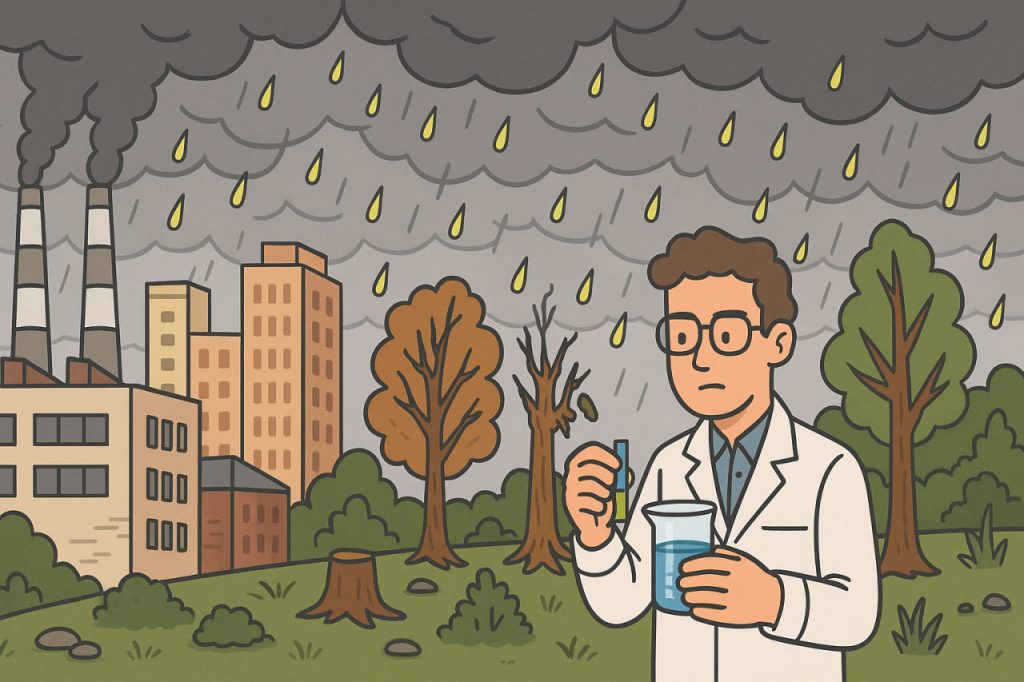Acid rain is one of the most harmful forms of atmospheric pollution. It occurs when sulfur dioxide (SO₂) and nitrogen oxides (NOₓ) emitted into the air react with water vapor, oxygen, and other chemicals in the atmosphere, forming sulfuric and nitric acids. These acids fall back to the ground through rain, snow, fog, or even dust — damaging ecosystems, infrastructure, and human health. Although acid rain peaked in severity during the 20th century, it remains a serious environmental issue, especially near industrial regions.
How Acid Rain Forms
The process begins with air pollution. Power plants burning coal and oil, vehicle exhaust, and industrial emissions release SO₂ and NOₓ into the atmosphere. These gases combine with water molecules and oxidize into acids. When rain or snow forms, it absorbs these acidic compounds and delivers them back to Earth.
A simple chemical summary:
- SO₂ + H₂O → H₂SO₄ (sulfuric acid)
- NOₓ + H₂O → HNO₃ (nitric acid)
Pure rainwater is slightly acidic (pH 5.6) due to natural carbon dioxide. However, acid rain can reach a pH as low as 4 or even 3, making it 100 times more acidic than normal rain.
Main Sources of Acid Rain
- Coal-fired power plants — historically the largest contributors.
- Industrial factories and metal smelters.
- Vehicle exhaust in urban areas.
- Volcanic eruptions — natural but temporary sources of SO₂.
While industrial countries have reduced emissions through clean-air policies, acid rain remains a problem in developing regions where coal and oil dominate energy production.
Effects on Nature
Acid rain affects almost every part of the environment:
- Forests
Trees exposed to acid rain lose nutrients like calcium and magnesium from the soil, weakening their roots and leaves. High-altitude forests suffer the most because acidic clouds and fog directly coat their foliage. - Lakes and Rivers
Acidic runoff from soil and rain lowers the pH of freshwater. Fish and amphibians die when water becomes too acidic for their survival. In Scandinavia and North America, thousands of lakes became biologically “dead” during the peak of acid rain pollution in the 1980s. - Soil and Agriculture
Acid rain leaches essential minerals from soil and releases toxic metals such as aluminum, which stunts plant growth and contaminates crops. - Built Environment
Acid rain corrodes buildings, bridges, and monuments — especially those made from limestone and marble. Historic structures like the Parthenon in Greece and cathedrals in Europe have suffered severe erosion.
Effects on Human Health
Although acid rain doesn’t burn skin directly, it harms humans indirectly:
- Respiratory diseases increase from inhaling fine acid aerosols.
- Contaminated water and soil can enter the food chain, affecting nutrition.
- Polluted air irritates eyes and lungs, worsening asthma and bronchitis.
What Humanity Can Do
Fortunately, acid rain is one of the few global environmental problems that has seen significant improvement — thanks to science and international cooperation.
- Reducing Emissions
- Install scrubbers in factory chimneys to remove sulfur dioxide.
- Use catalytic converters in cars to cut nitrogen oxide emissions.
- Transition from fossil fuels to renewable energy sources.
- International Agreements
Treaties like the 1991 U.S.–Canada Air Quality Agreement and the Convention on Long-Range Transboundary Air Pollution in Europe have dramatically reduced acid rain in those regions. - Liming of Lakes and Soils
In severely affected areas, scientists neutralize acidity by adding limestone (calcium carbonate) to lakes and soil, helping ecosystems recover. - Public Awareness and Monitoring
Education and regular air-quality monitoring help communities understand and prevent acid rain sources.
Global Outlook
While North America and Europe have made progress, South and East Asia still face increasing acid rain due to industrial growth. China and India, for instance, are now major contributors, though both countries are investing in cleaner technologies.
If global efforts to reduce fossil fuel use continue, acid rain could become a rare phenomenon by the end of this century.
Interesting Facts
- The term “acid rain” was first used in 1852 by Scottish chemist Robert Angus Smith.
- Some volcanic eruptions have caused short-term acid rain on a regional scale.
- Acid deposition can occur without rain, through dry particles settling on surfaces.
- Limestone buildings slowly “self-heal” through chemical reactions with CO₂, though erosion continues.
- Scandinavia’s recovery from acid rain is one of the greatest environmental success stories in history.
Glossary
- pH — a measure of acidity or alkalinity; values below 7 indicate acidity.
- Sulfate aerosols — particles formed from sulfur dioxide reacting in the atmosphere.
- Limestone — calcium carbonate rock often damaged by acid reactions.
- Catalytic converter — a car device that reduces toxic gas emissions.
- Ecosystem recovery — natural regrowth and rebalancing after pollution decline.


